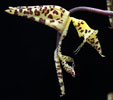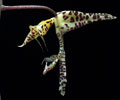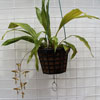|
|
|
|
|
| |
Flasks of
Gongora pleiochroma 'MC2764' × sib 'MC2752' |
|
| |
|
|
| |
| Number: |
TN4486 |
| Name: |
Gongora pleiochroma 'MC2764' × sib 'MC2752'
|
| Type: |
sib (What's that?) |
|
Seed Donor: |
Troy C. Meyers
|
|
Click to Enlarge

Pod Parent Flower |
Click to Enlarge

Pod Parent Inflorescence |
Click to Enlarge

Pollen Parent Flower |
Click to Enlarge

Pollen Parent Blooming Plant |
|
|
|
| |
Culture Notes from Donor: Pollen parent plant: Temperature range I (60-83°F)
Comments: Both parents are the offspring from our offering TN1768, Gongora pleiochroma '87131' x self which was pollinated in March of 2000.
Pod parent plant: Flowers are less widely spaced on the inflorescence than its sibling. Pleasant dessert-like fragrance.
Pollen parent plant: One of the offspring of our TN1768 effort of 2000. Medium-sized plant.
For additional origin/habitat information supplied courtesy of
Charles and Margaret Baker, see further below, near the bottom of this page.
|
Temperatures we attempt to use in the lab & greenhouse:
| For Species: |
|
Spring, Summer, Autumn, Winter: days average 82°F, nights 63°F; best fit is Intermediate 83-60°F
(Source:
Baker's Web OSC) |
|
About the name...
| Etymology of |
Gongora |
|
Named for Don Antonio Caballero y Góngora, viceroy of New Granada (Colombia) during the 18th century.
(Source:
Pridgeon 1992) |
| Etymology of |
pleiochroma |
|
From latinized Greek "pleio-" more, richly; "chroma" color. Richly colored.
(Sources:
Mayr & Schmucker 1998, Brown 1956) |
| Pronunciation of |
Gongora |
|
GON-goe-ra
(Source:
Pridgeon 1992) |
|
If you would like to direct someone to this web page, please copy and paste this URL into your email:
http://troymeyers.com/d?014486
| Flask Information |
| Availability: |
We have sold all of the flasks for this item. |
| You should: |
Consider getting individual plants or compots instead of a flask.
You can place a "Notify Flask Recipients" Request, and either we or a flask recipient may contact you when plants are available.
You may also place a "Notify Retries" Request, and if an identical pollination (the same parents) is done again, we'll let you know.
You may reserve a flask, but it's very unlikely you'll get one ...this could only happen if we found a flask that we didn't know we had. |
| Yield Estimate: |
300 plants (based on flask surveys done 02/16/2005 through 08/10/2005)
|
| Plantlet Sizes: |
From many flasks 45 - 120 mm plants (based on flask surveys done 06/10/2005 through 08/10/2005)
From one most recently surveyed flask 50 - 70 mm (08/10/2005)
|
|
You might also want to:
|
View the seed assay for this item.
View items of the same species.
View items of the same genus.
|
| Ordering Information |
| You are not currently logged in. |
|
You must be a registered user and be logged in to reserve a flask or place a notification request. Please log in:
|
|
|
|
|
|
| |
The origin/habitat information below is supplied courtesy of Charles and Margaret Baker
The following information is based on the name of the plant provided by the donor, and assumes that the name is correct. If the plant has been misidentified, then the following information may not be correct.
This text is copyrighted by the Bakers and may not be reproduced without permission.
ORIGIN/HABITAT: Peru, Colombia, and possibly the Guyanas and Brazil. This
orchid grows on the eastern slopes of the Andes from Iquitos, Peru toward
Manaus, Brazil at 1950-3300 ft. (600-1000 m).
More about this information and the Bakers...
|
|
|
| |
|
|
|